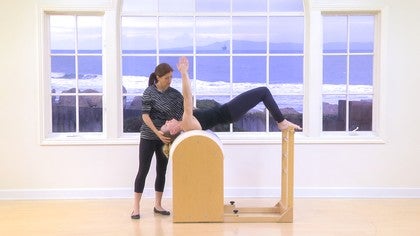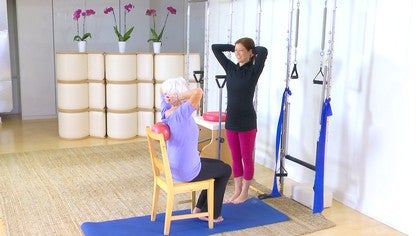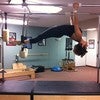Description
About This Video
Transcript
Read Full Transcript
Hi everyone. I'm here with Helen. She is coming to [inaudible] to improve her balance and to improve her knee mobility. She has some Baker, sits behind the knees, not a lot of pain in her knees, but difficulty just bending, which prevents her from getting down to the floor and back up again easily. And then we also want to work on the posture and um, overall body strength and endurance. Okay. So what I'd like to do is just take a look at Helen's posture in her natural state. And I just wanted her just to sit and relax and wait for me to work with her.
And as you can see that she's in a little bit of a posterior pelvic tilt and she has a little bit of roundness in her back, especially in this upper thoracic area that we'll be looking at. Um, one of the first things I w I love to do is just to put a ball behind the back to try to get a little bit of thoracic extension and just to promote some upright posture and that, that may change her posture quite a bit. So I have a squishy ball for starters and enough more firm balls. So we'll start with the squishy ball to make sure she tolerates it okay and I'll just place it behind the back and just, yeah, already her pelvis position change to a more vertical alignment and then her thoracic spine has changed also. So how does that feel as far as a comfort? Comfortable. Okay, cool. Cool, good.
Your feels like you're being pushed forward just a little bit, but in order to keep your head over your shoulders, you have to push back a little bit. So if you can keep the back of your neck lengthened and keep your eyes level and draw your chin down. I like to think of the, the neck muscles as like the abdominals of the neck. So when you draw those abdominals up and back, just like you would draw in the abdominals in the low part of your body, you would draw them up and back. And that helps to support the neck as well. And that will also promote a little bit more extension through that upper thoracic area. So let's trade balls for a moment. Now this ball is thicker and fuller, so it's probably going to require her to move her pelvis forward. So, so yeah, so she's not vertical anymore.
So you can scoot your pelvis a little bit forward. That's plenty. That's perfect. And then see where she works there. And then when she starts to do the thoracic extension mobilization before we start, then she can um, move the ball in different positions to get different vertebrae. So if the chair was even higher back, we would be able to get up here, which is where I'd like to get with her. And if in a later session I might have her in supine and put the ball underneath here and have her work in that area.
If I wanted to focus on that area or I could just be here and press the ball myself into her upper back. So now Helen, I'm going to keep the ball here and press that into your upper back. And what I want you to do is draw the throat back and think of drawing your face straight back. Exactly. And I'm going to prevent her from going back in the upper back and she's going to draw that last cervical vertebrae back as far as she can and then release. And then just let the head go forward. Great. And then pull the head back as if you're trying to get the head to touch the wall behind you. Draw the chin down a little bit and pull the throat back.
Nice. And then return. Okay. And now I'm going to put the ball back against the chair. Can you place your hands behind your neck and interlace your fingers? Bring the elbow slightly forward. And then lengthen is if you're giving yourself some traction to lengthen through the back of the neck and then draw the shoulders down. Good.
Now think of lifting the heart up, breathe in and breathe out. Returned to vertical, and your breastbone is going to be like a little seesaw going up and down on top of the ball. Inhale to take it back. Exhale, return to vertical. Notice I don't say come forward because that'll make you want to pull your head forward. So you'll want to avoid going forward. You just want to return to your optimal posture and then return. Beautiful. One more time. Inhale and exhale.
Now spread the shoulders or elbows wide and now go back and you're going to notice more of a chest stretch and not so much mobilization to the spine. So you're going to get that chest stretch as you do that one. Now stay there, bring your elbows forward. Now go back a little further so you can see how when you release the tension in the chest, you can go back a little bit further to bring the elbows even more forward. And then wrap that spine around the ball. Beautiful. And then returned to vertical, keeping the back of your neck long again. One more time. Inhale to take it back and then exhale, return. Beautiful.
And if we had a chair with more of a solid back, we would work our way down just a little bit. So maybe we would go to here and then once we get to the lumbar area, we would have to change the movement. So here we wouldn't want to go into the lumbar spine and then arch back. You'd want to do more of a pelvic curl, keeping the vertical alignment of the posture, and you're going to press back into the ball and then returned to vertical. Come forward just a little bit. Scoot forward in the chair just a little bit, Allen. That's it. And you can take your hands down. There you go.
So if we put the ball here and then you can do just a little bit of an abdominal curl. So sometimes if people are not getting on the floor for mat work, they lose out on those abdominal exercises that they could be doing to strengthen the abdominals and then returned to vertical. And then think of your pelvis being like a little wheel rolling back. Keep the ribcage lifted and then return. And again, exhale, curl the pelvis and then inhale, return the pelvis to that vertical alignment. One more time. Exhale, curl. And then inhale return.
So that ball gives a little bit of resistance to the abdominals. All right, so we'll take the ball away. Now I want to see, um, how you do getting up out of the chair. So if you could stand up for me. Okay. So she didn't need to use any assistance to get out of the chairs. You didn't have to push down on your hands. So your legs are strong enough to where you don't have to push down on your legs or your um, or the chair to get up. Um, the other thing I noticed was that your knees came together when you came up and that's something that we want to work on. Um, the other thing I'm noticing is that there's a little bit of pronation in your feet. Not, not a lot, but a little bit. And there's a slight Bunyon on each foot. Yeah, if you can notice that.
So this time when you sit down, what I want you to do is think of hinting at your hips, keep your knees separated and not your feet though. Cause so glue your feet to the Mat. That's it. And then pull your knees apart. I call this the Charleston move. So you're going to keep your feet planted and you're going to pull your knees apart. That's it. And then hinge at the hips, keeping your chest lifted as if you have a headlight shining forward and sit down. Okay, now see that's okay. That's okay. Now. So the springs are actually gonna help you with the movement so that you can do it more easily. So I'm going to give you the blue springs here.
They're quite heavy, so they're going to assist you quite a bit. Keep your thumbs up. That's it. And then pull the elbows down just a little bit as if you're trying to pull the breastbone through the frame of the arms. Now hinge forward and then stand up. Now look at your knees. That's it. There you go. Okay. Just reminding you about your knees.
So keep your knees apart and hands again. Stick your tailbone back. That's it. There you go. It's like you're lifting up your ducky feathers, right? So that's it. And hinge. And sometimes we want to facilitate that hinge by taking the arm across the upper back. And then I'm going to fold your hips a little bit here. That's it. So once you want to think about his nose over toes. Okay, so nose over toes.
That's it. And then on the next one I'll have you look up once you get your knee alignment. That was great. Keep the knees apart. Hinge at the hips. Beautiful. That's it. One more time. Great. Now when you're practicing at home, you want to make sure that you can feel the chair behind your legs before you sit. So scoot back just a little bit.
And if you wanted to practice this at home, you could take therabands or to being like this. Hook it up on the top of the door. You can create a loop. They sell loops at different polarities companies and you can slip the loop into the top of the doorframe and close the door. Or you can make a not in these. You just have to be careful that they don't break because they can break on the sharp edge of the wood. All right, so now hinge again and sit down.
That hip hinge is really important for her posture because if she rounds here, if you round here to come up, then you're going to keep that, that curve increasing in your upper back. So you want to keep your chest lifted knees apart. And I would say those are the main cues I would give you to, to practice your standing and sitting. Okay. All right. Now go ahead and stand all the way up again and then let it go here. I want you to hold on to the bars here and um, let me, I'm going to put these up here for a second. So just hold on right here.
There you go. Move the chair back a little bit and then I want to see how you're able to stand on one leg. So if you could stand on one leg and now let go of the bars. Very nice. Beautiful. Okay. Something that might help you is to think of focusing on a vertical line in front of you. So if you're practicing at home, you can look at a doorframe or some vertical line and that will help you stabilize your balance. As long as your eyes are focused on one point, that's also helpful as well. Now try the other leg and then there you go. And notice how when you're standing on this leg, this, I'm getting the feeling that you don't trust this leg very much as much as the other one, right? So what I want you to think about is standing back down on the floor with both feet.
Think of shifting your weight to the right and climbing up on top of that hip. Okay, so try that and get taller as you stand on that leg. So climbed up on top of it and lengthen your spine to stand. Yes, and that's going to facilitate some of the muscles in the hip and also in the, in the deep spine that are going to support you a little bit better. Okay, that looks great. All right, well done. Okay, now hold on to the bars here again. And then I want to see if you can extend your right leg behind you. Okay. And keeping this like straight and this like straight too and lift your leg as far as you can. Okay, good. Now keeping your pelvis square to the front.
What we want to see is that you can extend your hip as much as possible. You're feeling that in your back. Okay. That's exactly what we wanted to be working on is to make sure you have enough hip extension that you don't have to extension in your back every time you take a long stride. When you try to walk fast, you have to take longer strides when you walk. So if you could step forward with this right foot or left foot, sorry, left foot, it was the right foot. And then, um, actually step off the mat here and then step back as far as you can. And that's pretty good. Just straighten both legs. Okay. That might be, that's actually excellent. So square off your hips.
And then I want you to lift this hip a little higher. Good. And keep that knee straight. Lift up through the low belly that's going to help you support your back. And now see if you can keep both legs straight and send that right heel to the floor. Good. And then exhale it up and then send it to the floor and lift it up.
So at the same time you're stretching your right hip into more extension and you're also stretching your calf. Are you feeling that? And Are you feeling any pain in your back? Not as much as, okay, so maybe we need to shorten your stride just a little bit cause I don't want you to feel any pain in your back. And then lift through the low belly. That's it. There you go. And then send the heel back and then exhale to lift it up and again send it back and lifting it. Is that better? Yeah. Okay, good. All right. So my main thing is you want to keep the pelvis as vertical as possible so it doesn't tilt forward and the pubic bone doesn't drop and you arch your back cause that seems to give you some pain. Okay. All right.
Now let's switch sides and try the other side. So she's getting a lot of assistance from the bars here and we're going to start to decrease that assistant so she gets better at it. Scoop the low belly up a little bit. There you go. And keep both legs straight, send the heel to the floor and then rise up on your tippy toe. Think of sending the crown of your head toward the ceiling. Good, very nice and lengthen through the back of the neck and then send the heel to the floor. Exhale to lift up. Beautiful. And then again, breathe in, breathe out to lift up.
Good. Breathe into, send the heel down and breathe out to lift up. Very nice. Last one. All right, very good. All right, step together onto the mat and then we're going to hold onto these handles here. The Blue Springs, stepping back just a little bit and the springs are actually going to give you a little bit of assistance. Step forward with one foot and back with the other. Okay.
You might have to step back a little bit further to get more assistance from the springs. There you go. But you should be able to easily maintain your vertical posture. They should be so heavy that they're pulling you forward. All right, so pull the ribcage back over the pelvis. That'll be, that'll ease your back a little bit. All right, now rise up on your tippy toe and then back and down. Breathe out to lift up so much. Good. Breathe in and breathe out.
To lift up and breathe in. To step down and breathe out. To lift up. Beautiful. Step together and switch sides. Nice. Okay. Square off the hips. Pretend like you're standing on a little set of railroad tracks.
Spiraled his hip and just a little bit. There you go. Good. That's nice. And then breathe in. Breathe out. To lift up. Think of lifting your rib cage off your pelvis, kind of the head moves to the sky. Beautiful Spine posture. That looks great. And then send the heel down. Exhale, lift up. Inhale to send the heel and stretch and exhale lift up and one more beautiful and take it out. Great. Okay, now step right foot forward, left foot back. We're going to add to it now.
All right, so give enough assistance that you feel like you're getting supported by the springs. Okay, got that. All right. Now what I want you to do is imagine that you're a piston and you're going to go straight up and down. And I want you to bend the front knee just a teeny bit and bend the back knee just a teeny bit, bringing the heel higher. So you're going to put on your high heel shoes for this one. All right? And it goes straight down halfway. That's it.
And then exhale back up. Good. And does that feel okay on your knees and your back? Yeah. Okay. Inhale to take it down and exhale app. So you want that long strive, so you decrease some of the pressure in your knee joint. Breathe and take it down and breathe out to lift up.
And one more time and you go down and now go see if you can pull on the springs a little bit and go down a little bit further. I'm going to see how much you can bend that knee. Go ahead. All right, and that's about the separate them a little more. Yes, I would love that. I'd love for you to separate them. Yeah, that's great. That puts a lot less pressure on your knees. Okay, so make sure your body doesn't go forward. You want to stay back and then take it up and then just go down as far as you can comfortably pull on the springs if you need assistance. Beautiful.
And then take it back up and again, one more time. Inhale to take it down and exhale coming up now. Step together. See if you can go one step. Perfect. That's great. Other leg.
There you go. Rise up on your tippy toe back. Heel stays lifted like you're wearing a high heel shoe bend both knees. That's an end. Going straight down and then back up again. Breathe in to go down and take it up and breathe in to come down. Beautiful. All the way down, all the way back up so that assistance can really decrease some of the pressure in the knee joint and make it more easy for you to do the exercise and practice the good alignment. Excellent. Okay. Now the progression would be [inaudible] to change the springs to yellow.
You're okay with that? Let's change the springs to yellow, which are lighter. They're going to give you less assistance.
Now you might have to step back just a little bit more to get more assistance if you need it, but the ideal would be if you don't need any assistance at all. Okay, so step forward with one foot and back with the other square off your hips. Straighten both knees, lift up, rise up a little higher on that back heel. That's it. Good. All right. Now fold the back knee underneath and then bring that knee forward underneath. That's it. And then come back up again. How does that feel?
You're okay with that? Yeah. Okay. And you can bend your arms a little bit more to get more assistance if you need it. Breathe in to come down and then exhale going up and take it down again. And uh, so often what people will do, she's not doing this, but often what people will do is they will go forward in the lunge and put all the weight on the front knee and then the front knee will be loaded way more than the back knee. So let's try the legs. And so often what I will do is I will put my arm here and say, don't touch my arm. No. Stay away from my arm. So you don't see, don't go forward. So you don't travel it forward. Oh, okay.
So you go straight down, fold that back knee underneath, bring that heel a little higher over the back foot. That's it. So it comes forward and then come back up. And sometimes people have to wear shoes when they do this because they don't have enough mobility in the great toe. I'm the joints of the toes. Don't have, so yeah. Okay. And you're not having pain without though, are you? No. Oh, all the way down. Great. One more time. Take it all the way down and then exhale back up.
And normally would do about 10 of any of these exercises to fatigue. So until you feel a little shaky, a little quivery and then we would start to decrease the amount of assistance. What we would do to progress, and especially if you're at home, um, is to take a chair and a dowel. A broomstick is fine. You can face that way and a broomstick is fine. Um, for home you can take the broom off the handle or not. What you have to be careful for is that these have little rubber stoppers on the ends, but your broomstick won't have that at home.
So if you're putting it on a hard floor, it could slip. So you want to make sure that you have rubber stoppers on the end. If you're using a hard floor, but likely you'll be using a yoga mat. Just make sure the stick is on the yoga mat or a carpet. Okay. Now step forward with one foot and back with the other square off the hips.
Straighten the legs first, that's it. And Rise up on your big toe or on your um, TB toes of the back foot. And then bend the knees and come down. Breathe in, that's it. And breathe out to come back up. Excellent. Now you can let go of the chair and just hold the dowel and then take it down and back up. Great.
And you want to make sure you're not going forward too much. So I'm going to put my hand here and you're going to stay away from my hand. Great. That's it. Okay. Now she's found her challenge point, you know, all right. That's what I was looking for is the challenge point. Alright. Step together and then excellent. So you can understand the progression there. All right.
The other thing we could do is I'm taking the dial behind your back and placing the dial against the head, the mid back and the sacrum. And now length in the back of your neck. Exactly. And stand on. Keep your eyes level. Don't bring your eyes down just a little bit. There you go. So you're really trying to keep the back of the neck lengthened and the throat pulling back a little bit. There you go. And then lift one leg, that's it. And try to keep your head against the stick so they're exactly okay. And then step together.
And then you could take the doll away and use it for balance. So let's have you put it in your left hand and then stand on your left leg again. Thinking of climbing up onto that leg. Now, point the leg forward and then bring it in to, I call it the stork position, and then pointed out to the side and then bring it into the stork position and then extend it back. But really think of lifting through that low belly so you don't arch your back when you extend it back. Keep your knees straight and touch your toe to the floor. There you go. That's it. And then bring it back to the stork position. Good.
And let's change sides. All right. And then shift the weight to the right. Remember to climb up on top of that hip and then extend the right leg forward and then bring it back in. It doesn't have to be very high and bend your knee and come to the stork position. So like this? Yep. There you go. And then point the leg out to the side and keeping the, the waistline lifted here. Shoulders down, that's it.
Square pelvis to the front. And then bring the leg back into your stork position and then point to the back. That's it. And then back to the stork position. Great. Hold that position here. Now Rise up on your tippy toe. That's it. Okay. And then again, and up and down.
Let's do 10 times and exhale. Three and four and five and six. Crown of the head aims to the ceiling reaching a two more. Excellent. Last one. Great. Excellent for knee strength. So to help your knee be a little bit stronger in your ankle, be a little bit stronger. That's helps to support the knee. All right.
Shift the weight to the other leg and the dial to the other side. Exactly length and through the back of your waistline. So as you step onto this leg, you want to watch that you're not sinking into the back of your waist and your ribcage isn't dropping down in the back. So I often tell people to think of keeping their kidneys lifted. Okay. And then draw the shoulders down. Exactly.
Now shift your weight to the left and lift up the right leg. Breathe in and breathe out to lift up on your tippy toe. Yup. To be done one and down and exhale to keep the back of the waist lifted. Three going straight up and down.
Four and five and six, seven, eight. Very nice. Or keeping your knee very straight. Last one and down. Excellent. So she could definitely use the bars if she needed to, to give her a little bit more support because I'll often, you'll see that people bend their knee when they tried to go up on one foot and that's a sign of calf weakness. So she could hold onto the bars to do it for a little while until you have more strength. But you had enough strength to be able to do it here. That's great. Okay, so now we're going to add a little bit of resistance.
So I'm going to have you hold on to the um, bars right here and here. And I'm going to bring this up a little bit and let's put the spring on the right foot first. I'll just stand down onto the spring on a roll that pant up a little bit. Okay. Holding the shoulders down, chest lifted. And remember that low belly is going to stay lifted.
Extend the leg back behind you, keeping the foot pointed so you keep the spring on your leg and then lift and then return. Now you could, if this was bothering your back, you could bend this knee and tilt forward just a little bit, Helen. There you go. And lift your heart. That's it. All right. And then straighten this leg. That's it. Now really want to get that glue to fire and then lift up and not just depend on the hamstring. So I want to make sure that knee stays really straight even more. That's it. Cause that hamstring. Yeah. Really wants to take over.
So this is why we all have tight hamstrings and weak glutes cause our hamstrings have a type a personality disorder and our glutes say, Oh let the hamstrings do it. That's it. Nice and really keeping that knee straight. That's it. So sometimes come down to the floor, put the foot on the floor, take a moment to straighten that knee and really feel how that feels to have your knee straight. Now keeping that straight leg, lift the leg again, that's it. And you see that glute fire there. Perfect. That's exactly what I want to see. Okay, that's fine. [inaudible] and really lengthening through here.
That's it. Good. Now go ahead and stand into the spring. That's it. And turn to the side here and you're going to place your left hand on the bar and if you need a dowel in your right hand, we can do that. But I'll hold your hand for right now. Okay. Now you're going to take the leg straight out to the side with some resistance and then keep the body vertical that's, and then hold that hand out a few like lengthen through the waistline and then lift and return a, keep your heel down. That's good though. Yeah, you get extra credit points for that. And then axial, lift the right leg up and then bring it back to the start position.
Keeping the knee straight. Pretend like you're against a wall and you're going to drag your heel against the wall behind you. Lifting up straight back like that. That's it. And down and straight out to the side and down. Now fold at that hip. Exactly. So I'm going to give you a little bit of a visual.
So here's what's happening that, so see if you can keep the pelvis and down as you lift the leg out to the side. So it's a small movement. That's it. Yes, exactly. You needed a little bit of a visual. That's perfect. There you go. Very important muscle to strengthen. This is your balance muscle. These are your pelvic stability muscles, the Gluteus medius muscle here.
Great. That looks good. Okay, now let's step out of that loop. Now we'll go to the other side and you can face the bars. We'll do extension first. We have the spot. Okay. Step into the leap here. Stand onto the foot. There you go.
Standing Tall. That's it. Extend the leg back behind you. Keeping your foot on the floor. Take a moment to straighten that knee and really feel what that feels like to keep the knee straight. Then lift the leg. Great. Keeping the knee straight. Open that back of that knee. That's it. And then lift.
So it's like you're trying to lift your knee cap up and then lift your leg. And again, exhale, lift and lift. That's it. Getting better. Perfect. Breathing out, keeping the heart lifted back of the waistline lifted. That's it. Lovely. All right, now stand into the spring and face me.
Take your right hand and put it here. Perfect. All right, and then you're going to keep the pelvis level just like you did on the other side. Reach this arm out to the side and then sweep the leg out. [inaudible] and again, keeping the pelvis down on this left side. That's better. Good. Really Nice. And reach and reach. It's almost like you're trying to reach across the room and and down instead of so far up. Yes, that's it.
So you're starting to stretch that heel across the room. Beautiful. Okay. Stay there for just a moment. I'm going to bring in the moon box and then I'm going to have you stand on the moon box here. Okay, perfect. Now you can really reach that heel towards the floor and then lift. But sometimes the moon box is a little bit squishy and is an unstable surface, so you're certainly able to do this.
That looks great because we know that challenging higher levels by putting you on an unstable surface actually increases the ability to do lower level exercises and movements. Great. That looks good. Nice. Okay. And then step down. All right, let's do this out of the way. Let me get this spring off your leg. Nice. And you could do any of those exercises again with the, with the theraband tied to the doorknob and holding it onto your foot. Okay. So now we're going to use the one to chair. Okay. All right, so now we're going to use the one to chair in combination with the wall unit.
I'm going to have you sit here, but first I'm going to push the pedals down so that you can get in there more easily. You can actually stand on the wood part. Okay. And then sit down and I want you kind of perched on the edge of the chair. Yes, that's it. So that'll keep you from um, being able to slide back off the chair. That'll keep you perched on there. All right, now put your feet on the pedals and you want the balls of your feet on the pedals. And I want you to sort of put on a high heel shoe position. That's this. You want to keep the arch lifted in the heel lifted slightly throughout the whole movement. And I'll remind you if you, if you allow them to drop. All right, now hold on to these handles for a moment on the outside.
I like to actually keep the handles on there and let you rest your hands like that. Yeah, and that kind of opens up the chest a little bit and gets you upright. Very good. All right. Now keeping the pelvis rolled slightly forward, is there any discomfort in your back right now? No. All right, so allow the pedals to come up without moving your spine, so you're going to take the pedals up and see if you can keep your spine and pelvis perfectly still and let's just see how far you can flex your hips. Perfect. Keeping the heels lifted, that's it. And then press the pedals back down. Great inhaled to take them up and exhale, taking them down and then I'm going to bring this back here to give you a little reminder and then tilt your body forward just a little bit. That's it. There you go. Perfect.
That looks beautiful. Exactly. Okay. Now I'm going to take the this blit apart and now the pedals will be separately controlled by each leg. Bring your head back into alignment and I want, what I want you to do is press both pedals down all the way. Can you hold them down? That's it. See if you can let go with your hands. Ah, okay. And just reach your arms straight up. That'll be fine.
Take the shoulders back and down so that you can keep your chest lifted. Good. All right, now allow one pedal to come up. That's it. Without moving the pelvis. Exhale to press it down. Inhale to lift the left pedal. Exhale to press it down. Beautiful. Inhale to lift the right and down. Good.
Now take both pedals up, trying to keep them even as you come up. Breathing in, folding at the hip. Keep the heels lifted and press it back down. Nice. And then take it up three times. Breathe in to come up and breathe out. To press down one more time.
Take it up and down. Good. All right. Just for ease and simplicity, I'm going to put this, split the bar back in to connect the pedals together. I'm going to have you hold onto these. Okay. Now these handles, um, can be removed. But what I would like you to do is just keep your elbows down by your sides as you do this, this pole so you don't hit your elbows on the handles and then take the arms forward and then just keep your legs still for a moment and just do a couple of rows. Exactly. That's it. Hold the shoulder blades towards each other a little bit.
Lean forward a little bit in the body. That's better. That's better. There you go. Keeping the ribcage balanced over the pelvis. Okay. Now we're going to push both pedals down as you pull. Nice. And then back up. Exhale, press the pedals down as you pull and back up. One more time. Beautiful. Okay, now you're going to press just the right pedal down and pull just the right arm.
The coordination. There you go. That's it. Oh, I have to blue. Flip the pedals of course. Okay. All right. Now there we go. Leaning forward a little bit more. That's it. Stay perched on the top of that pelvis. That's it. Right. Pedal goes down, right arm goes back and then left and back.
Exactly. Beautiful. Okay, rest for just a moment. You okay? In that position, I'm going to take the handles off so that she can do rotation. All right, now press the right pedal down. As you rotate to the right, like you're a bow and Arrow and you can take the elbow up, just a little higher shoulder down and back. So I'm going to help you rotate a little bit more. Looking over that right shoulder. That's it. And then back to center. Think of putting your shoulder blade in your back pocket. Now rotate left.
That's it. And back to center and that's okay. Right pedal down as the right arm rotates and pull that shoulder back and down in the socket. Let's bring this elbow forward a little bit more and focus more on bringing the shoulder blade and the shoulder joint back a little bit more. Pull the elbow down a little higher, a little lower. Sorry. That's it. And then pull the armpit down toward the hip. Can you do that? That's it.
Yes. There you go. And then take the arms forward and then left arm down and back. Keep the shoulder down. That's it. And then return. All right. Right shoulder down and back. Armpit down a little lower. Take the shoulder bone and pull it down in the socket a little bit more.
That's it. That's it. How a nice and then left pedal goes down as left shoulder blade goes down. There you go. Good. So you're focusing more on getting the shoulder blade back instead of the elbow back so far. Oh yeah. And an elbow can come out a little bit, but now armpit goes down, shoulder blade goes down and back right there. That's it. Okay, so that's something that we could work on a little bit more. I think separately from the pedals, really focused on getting the shoulder to stay down as you pull it back.
Well that armpit action is really helpful there. So take the arm forward, press down into my hands. Yes, that's it. Now pull the elbow back as you rotate. Keep the armpit pressing down into my fingers. Yes, that's it. Exactly. And then take that arm forward and then do the same with the left, left arm pit pulls down and back shoulder stays down in the socket. That's it. Don't pull the elbow back any farther. Pull this back further. Yes, exactly. That's perfect. Let's do that again on this side. You've got the idea.
Beautiful. That's it, Helen. You've got it. So you want to keep that pressure on my fingers. One more time to the left. Exactly. Beautiful. All right, we're going to do one more little exercise. So I'm letting the pedals come up and just, um, I'm going to push the pedals up. I'm going to hire, that's it. And you can step onto the floor.
Good. All right, so this is my sit fit desk or balanced desk where every time I put somebody on there, they usually laugh. So it's okay to laugh. All right, so you gonna have a seat here. I'm going to hold your hand because it will be unstable and then, um, let me, I'm gonna put the stick back in just to help you with that. I'm going to press the pedals down so that you can get on there. The hardest part is getting on. Oh, there you go. Now you can get on the middle of it there. Perfect. Okay, so now we're going to challenge your trunk control a little bit, and then again, placing the balls of your feet on the pedals. Lift the heels. All right, and you can take the arms forward if it helps you with your balance. That's it.
Draw the armpits down and back. Perfect. All right, now keeping your balance. Let the pedals come up. Breathe in to take it up. Think of folding at your hips, and then press the pedals back down. That's it. Bring the pedals up, breathing in and breathe out to press the pedals down. Great. Okay, I'm going to stop helping you with my foot. That's it.
Beautiful. Exhale, harassing the pedals down and then take them up. All right, turn your palms up. Take your arms out to a tee position, opening the chest, beautiful. As you press the pedals down, rotate to the right, lovely. And then keeping the armpits pulling down, and then press the pedals down in. Rotate left armpit pulls down here. Good. That's it. And then take it back to the center. One more time. Each side. Exhale, rotate. Inhale. Return, spiraling up.
Keeping the back of the waistline lifted and rotate. Left. Lovely. And take the arms all the way back down. I'm going to press the pedals down and we'll help you come off of here. Take it all the way up. All right. And then stand just facing me here.
Bring your feet all the way together and then lift the toes as if you're going to lift the arches of your feet. Yes. And let that, that toe lift help you lift the arches of your feet and then place about 60% of the weight on the outside of the foot. 40% to the inside. Yeah. And then think of bringing your pelvis into a vertical position so that you're not arched and you're not tucked. The buttocks are relaxed. Yeah. The waistline is lifted, your ribcage is balanced over your pelvis, back. Muscles are relaxed, collarbones are open, throat is lifted up, and now rise up on your tippy toes and back down. Draw your heels together as if you're as if you're holding a credit card in between your heels.
It's a Neiman Marcus credit card and it has an unlimited balance. Right? So draw those heels together and then back down. Exactly. And one more time. Lifting up and down. Much better. That's it. Full that your hip joints. Beautiful. Thank you so much.
Bone Health: Standing and Chair Workouts
Comments
You need to be a subscriber to post a comment.
Please Log In or Create an Account to start your free trial.

































